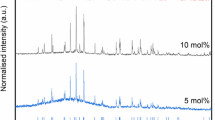Abstract
Argonne National Laboratory is developing a method to treat spent nuclear fuel in a molten-salt electrorefiner. Glass-bonded zeolite and sodalite are both being developed as ceramic waste forms. The ceramic waste form will contain the fission product (e.g., rare earth, alkali and alkaline-earth metals, halogens, and chalcogens) and transuranic radionuclides that accumulate in the electrorefiner salt. Zeolite A can fully incorporate both the salt and the radionuclides into its crystal structure. Salt-loaded zeolite A is mixed with glass frit; the blend undergoes hot isostatic pressing to produce a monolithic leach-resistant waste form. Alternatively, the salt-loaded zeolite may be converted to sodalite simply by heat treating first, then adding the glass and hot pressing.
Similar content being viewed by others
References
Arturo Uccelli,Leonardo da Vinci (New York: Reynal and Co., 1956).
S.P. Timoshenko,History of Strength of Materials (New York: McGraw-Hill, 1953).
I. Todhunter and K. Pearson,History of the Theory of Elasticity and of Strength of Materials, sections 1503 and 936 (Cambridge: University Press, 1886).
P. Ludwik,Elemente der Technologischen Mechanik (Berlin: Junius Springer, 1909).
T.E. Stanton and R.G.D. Batson,Proceedings of the Institute of Civil Engineers, 192 (211) (1920), p. 67.
Editorial Note,Engineering (3) (1933).
H. Neuber,Kerbspannungslehre (Berlin: Julius Springer, 1937).
A.A. Griffith,Philosophical Transactions of the Royal Society (A), 221 (1920), p. 163.
Shearin, Ruark, and Trimble,Fracturing of Metals (Cleveland, Ohio: ASM, 1948).
G.R. Irwin,Fracturing of Metals (Cleveland, Ohio: ASM, 1948).
G.R. Irwin and J.A. Kies,Welding Journal, 31 (1952), p. 95s.
G.R. Irwin and J.A. Kies,Welding Journal, 33 (1954), p. 193s.
First report of special ASTM comm,ASTM Bulletin (January) (1960), p. 29.
J.R. Rice,Fracture. vol. II, chapter 3 (New York, Academic Press, 1968).
Additional information
C. Pereira earned his Ph.D. in chemical engineering at the University of Pennsylvania in 1992. He is currently an assistant chemical engineer at Argonne National Laboratory. Dr. Pereira is a member of TMS.
M. Hash earned his M.S. in metallurgical and materials engineering at Illinois Institute of Technology in 1993. He is currently an engineering specialist at Argonne National Laboratory.
M. Lewis earned her Ph.D. in chemistry at the University of Pittsburgh. She is currently a chemist at Argonne National Laboratory.
M. Richmann earned his Ph.D. in chemistry at Chio State University in 1991. He is currently an assistant chemist at Argonne National Laboratory.
Rights and permissions
About this article
Cite this article
Pereira, C., Hash, M., Lewis, M. et al. Ceramic-composite waste forms from the electrometallurgical treatment of spent nuclear fuel. JOM 49, 34–40 (1997). https://doi.org/10.1007/BF02914764
Issue Date:
DOI: https://doi.org/10.1007/BF02914764




